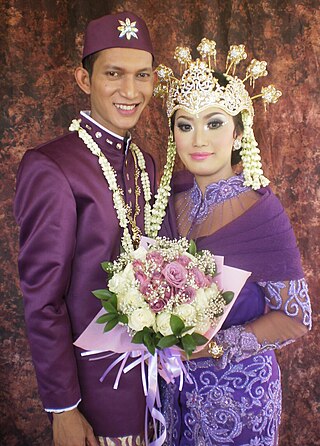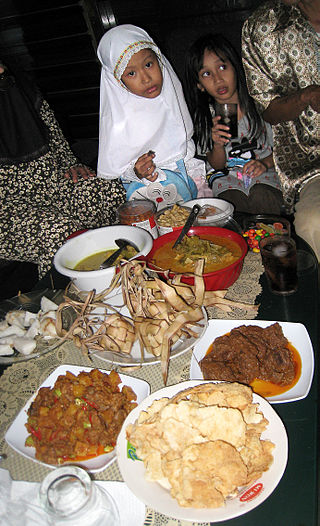
Kerja Tahun, or Merdang Merdem, is a week-long annual festival held by the Karo people of North Sumatra to celebrate the rice-planting. 'Kerja' in this sense is a Karo word meaning 'party', and not the Indonesian 'kerja', which means work. [1]

Kerja Tahun, or Merdang Merdem, is a week-long annual festival held by the Karo people of North Sumatra to celebrate the rice-planting. 'Kerja' in this sense is a Karo word meaning 'party', and not the Indonesian 'kerja', which means work. [1]
Rice-planting has historically held great importance for the Karo people, rice being the staple food of the region, as well as an important source of income and indicator of wealth, in the size of one's rice barn. The Karo traditionally planted rice once per year, using dry rice (in Indonesian 'ladang') cultivation. Rice cultivation has an important role in the traditional Karo religion (known as pemena [2] ).
In order to ensure the success of the rice-planting, the Merdang Merdem festival is conducted, paying homage to Beru Dayang, a female spirit also associated with childbirth, a process with which the rice planting is analogised by the Karo.
The kerja tahun festival does not have a fixed date in the Karoland, but varies by village. Despite the decline in traditional beliefs, as well as the decline in the number of people growing rice (due to modernisation and the switch to other crops), the kerja tahun festival is still widely held, but now as an activity with greater significance in terms of kinship and cultural bonds than as a religious practice.
The festival lasts six days, with a seventh day of rest: [3]

The Japanese New Year is an annual festival that takes place in Japan. Since 1873, the official Japanese New Year has been celebrated according to the Gregorian calendar, on January 1 of each year, New Year's Day. Prior to 1872, traditional events of the Japanese New Year were celebrated on the first day of the year on the modern Tenpō calendar, the last official lunisolar calendar.

The Sui people, also spelled as Shui people, are an ethnic group living mostly in Guizhou Province, China. They are counted as one of the 56 ethnic groups officially recognized by the People's Republic of China.

The Sundanese are an Austronesian ethnic group native to western region of Java island in Indonesia, primarily West Java. They number approximately 42 million and form Indonesia's second most populous ethnic group. They speak the Sundanese language, which is part of the Austronesian languages.

Dusun is the collective name of an indigenous ethnic group to the Malaysian state of Sabah of North Borneo. Collectively, they form the largest ethnic group in Sabah. The Dusun people have been internationally recognised as indigenous to Borneo since 2004 as per the United Nations Educational, Scientific and Cultural Organization (UNESCO).

Gawai Dayak is an annual festival and a public holiday celebrated by the Dayak people in Sarawak, Malaysia on 1 and 2 June. Sarawak Day is now celebrated on July 22 every year. Gawai Dayak was conceived of by the radio producers Tan Kingsley and Owen Liang and then taken up by the Dayak community. The British colonial government refused to recognise Dayak Day until 1962. They called it Sarawak Day for the inclusion of all Sarawakians as a national day, regardless of ethnic origin. It is both a religious and a social occasion recognised since 1957.

Parkia speciosa, the bitter bean, twisted cluster bean, sator bean, stink bean, or petai is a plant of the genus Parkia in the family Fabaceae. It bears long, flat edible beans with bright green seeds the size and shape of plump almonds which have a rather peculiar smell, similar to, but stronger than that of the shiitake mushroom, due to sulfur-containing compounds also found in shiitake, truffles and cabbage.

Thingyan, also known as the Myanmar New Year, is a festival that usually occurs in middle of April. Celebrated over a period of four to five days, Thingyan culminates in the New Year. The dates of Thingyan are calculated according to the Burmese calendar. Thingyan is observed as public holidays throughout Myanmar, and are part of the summer holidays at the end of the school year. Water-throwing or dousing one another from any shape or form of vessel or device that delivers water is the distinguishing feature of this festival and may be done on the first four days of the festival. The New Year coincides with new year celebrations throughout Southeast Asia and South Asia, including Songkran in Laos, Songkran in Thailand, the Cambodian New Year, the Sinhalese New Year and the festivals like Vaisakhi (Punjab), Puthandu, Vishu (Kerala) and Bihu (Assam) in India.

The Karo people are a people of the Tanah Karo in North Sumatra, Indonesia. The Karo lands consist of Karo Regency, plus neighboring areas in East Aceh Regency, Langkat Regency, Dairi Regency, Simalungun Regency, and Deli Serdang Regency. In addition, the cities of Binjai and Medan, both bordered by Deli Serdang Regency, contain significant Karo populations, particularly in the Padang Bulan area of Medan. The town of Sibolangit, Deli Serdang Regency in the foothills of the road from Medan to Berastagi is also a significant Karo town.

Chinese New Year, or the Spring Festival, is a festival that celebrates the beginning of a new year on the traditional lunisolar Chinese calendar. Marking the end of winter and the beginning of spring, this festival takes place from Chinese New Year's Eve to the Lantern Festival, held on the 15th day of the year. The first day of Chinese New Year begins on the new moon that appears between 21 January and 20 February.
The Apatanis who inhabit a tranquil pine clad valley called Ziro at the core of Lower Subansiri District of Arunachal Pradesh, are famous for their unique practice of wet rice cultivation. They are also known for their sustainable agricultural practices and the agricultural cycles govern their everyday lives. The agricultural festival of Dree is the highlight in this cycle.

Batak architecture refers to the related architectural traditions and designs of the various Batak peoples of North Sumatra, Indonesia. Six groups of Batak speak separate but related languages: the Angkola, the Mandailing to the south, the Toba, to the north the Pakpak/Dairi, the Simalungun, and the Karo. While the groups are now Muslim or Christian, elements of the ancient Batak religion remain, particularly amongst the Karo.

Lebaran is the Indonesian popular name for two Islamic official holidays, Eid al-Fitr and Eid al-Adha in Indonesia, and is one of the major national holidays in the country. Lebaran holiday officially lasts for two days in the Indonesian calendar, although the government usually declares a few days before and after the Lebaran as a bank holiday. Many individuals or families, especially Muslims take paid time off from their workplace during these days.
Cimpa are a variety of related cakes cooked by the Karo of North Sumatra, made of rice flour, coconut and palm sugar.
The Changs are a Naga ethnic group inhabiting the Northeast Indian state of Nagaland. They were also known as Mazung in British India. Other Naga ethnic groups know the Changs by different names including Changhai (Khiamniungan), Changru (Yimkhiung), Duenching, Machungrr (Ao), Mochumi (Sümi) and Mojung (Konyak).
Ancient diet is mainly determined by food's accessibility which involves location, geography and climate while ancient health is affected by food consumption apart from external factors such as diseases and plagues. There are still a lot of doubt about this ancient diet due to lack of evidence. Similar to what anthropologist Amanda Henry has said, there are a lot of time periods in the human history but there are only theories to answer questions on what people actually ate then. Only recently have traces been discovered in what was left of these people.

Ketupat, or kupat, or tipat is a Javanese rice cake packed inside a diamond-shaped container of woven palm leaf pouch. Originating in Indonesia, it is also found in Brunei, Malaysia, Singapore, southern Philippines, southern Thailand, Cambodia and Laos. It is commonly described as "packed rice", although there are other types of similar packed rice such as lontong and bakchang.

Dodol is a sweet toffee-like sugar palm-based confection commonly found in Southeast Asia and the Indian subcontinent. Originating from the culinary traditions of Indonesia, it is also popular in Malaysia, Singapore, Brunei, the Philippines, Southern India, Sri Lanka, Thailand, and Burma, where it is called mont kalama. It is made from coconut milk, jaggery, and rice flour, and is sticky, thick, and sweet.

Slavic carnivals are known under different names in various Slavic countries: Bulgarian: Сирни заговезни, Прошка, Поклади, romanized: Sirni zagovezni, Proshka, Pokladi; Macedonian: Прочка, romanized: Pročka; Russian: Масленица, Мясопуст, romanized: Maslenitsa, Myasopust; Polish: Ostatki, Mięsopust, Zapusty; Czech: Masopust, Šibřinky, Ostatky; Slovak: Fašiangy; Slovene: Mesopȗst, Pust, Pustni teden, Fašnk; Serbian: Покладе, Проћка / Poklade, Proćka; Croatian: Pust, Poklade, Mesopust, Fašnik. They are traditional Slavic festivals related to the period of carnival.

Gyalpo Losar is a new year festival of Sherpa people of Nepal, Sikkim and Darjeeling. The festival is celebrated every year from Falgun Shukla Pratipada, the second day of the waxing moon until the full moon.

The National Institute of Health Research and Development was a supporting unit of the Ministry of Health which is responsible for state research, development, and innovation in the field of health and medical sciences. The agency dissolved and liquidated into National Research and Innovation Agency (BRIN) on 31 December 2021 as part of BRIN state research activity integration plan.